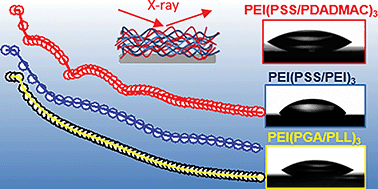Interfacial and structural characteristics of polyelectrolyte multilayers used as cushions for supported lipid bilayers
Abstract
The surface properties of polyelectrolyte multilayers (PEMs) obtained via sequential adsorption of oppositely charged polyions from their solutions and used as cushions for supported lipid bilayers were investigated. Five types of polyelectrolytes were used: cationic polyethyleneimine (PEI), poly(diallyldimethylammonium)chloride (PDADMAC), and poly-L-lysine hydrobromide (PLL); and anionic polysodium 4-styrenesulfonate (PSS) and poly-L-glutamic acid sodium (PGA). The wettability and surface free energy of the PEMs were determined by contact angle measurements using sessile drop analysis. Electrokinetic characterisation of the studied films was performed by streaming potential measurements of selected multilayers and the structure of the polyelectrolyte multilayer was characterized by synchrotron X-ray reflectometry. The examined physicochemical properties of the PEMs were correlated with the kinetics of the formation of supported lipid bilayers atop the PEM cushion.



 Please wait while we load your content...
Please wait while we load your content...